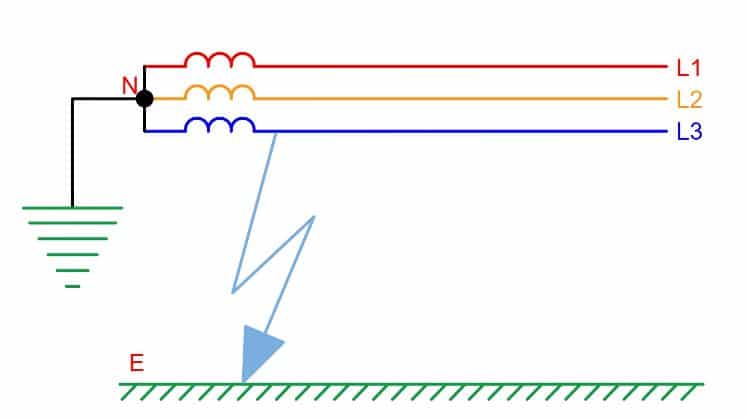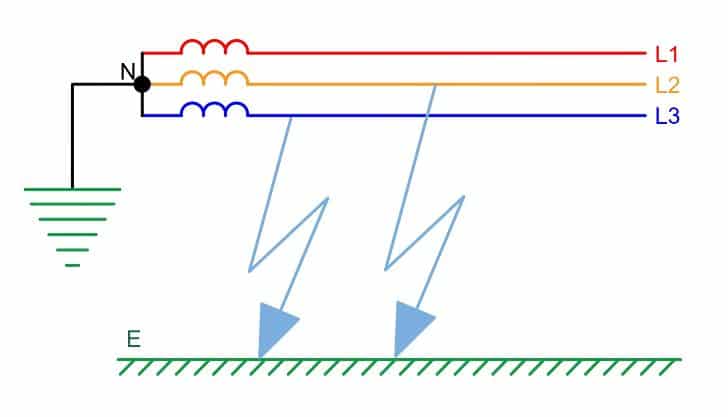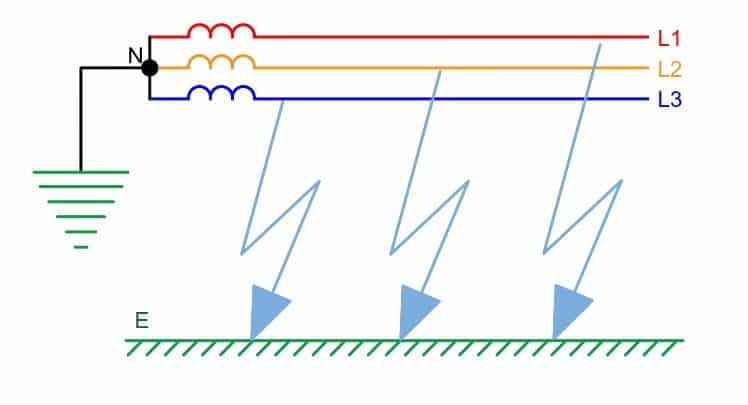Ground Fault
Ground Fault & Earth Fault- When the live conductor touches a ground point, the heavy current flows from the live phase to the ground is called a ground fault.
Earthing and grounding both are a process of connecting an electrical system to the ground.
Earthing process means connecting the dead part (the part that doesn’t carry current under normal conditions like electrical panels, motor body) to the earth. The grounding process means connecting the live part (that is the part that carries current under normal conditions like the neutral of a star-connected transformer) to the earth.
In North American standards like IEEE, NEC, ANSI, and UL the grounding term is used, and in European, commonwealth countries and Britain standards like IS and IEC, etc earthing term is used.
The ground fault may occur in three ways.
1. Single–Line-to Ground Fault(L-G fault)

In a single line to ground fault, one live phase touches to ground. The fault current flows from the live phase to the ground. The other two healthy phases supply the fault current.
2. Double-line-to Ground Fault(L-L-G fault)

In this situation, two live phases touch the ground and fault current flows from two phases to the ground. The third healthy phase supplies the fault current.
3. Tripple-Line-to-ground fault (L-L-L-G Fault)

Triple line-to-ground fault occurs when three live conductors touch to ground.
Reasons of Ground Fault
The reason for the ground fault in an insulated conductor is overheating of the cable. This may be due to the flow of electric current being more than the conductor current rating. The excessive current causes heat loss & temperature rise in the conductor. As we know, the insulation life deteriorates if operates above its specified temperature range. The temperature rise may fail the insulation & eventually, there may be a line to ground fault.
The other reasons for ground fault are loose connections & aging of the insulation. The loose connection cause increase in contact resistance & thus there would be higher heat generation at points of contact. This further cause the temperature increase of the insulation. And, finally, cause insulation failure.
During storms, the overhead line conductors may touch the neighboring tree branches. It may cause the line to ground fault. Though these types of arching faults clears by auto closure operation, the necessary preventive action is must to avoid these types of faults.
The breaking of the overhead conductor is also the reason for phase to ground fault.
The ungrounded system where the neutral point is not grounded may cause a rise in voltage of healthy phases, & this high voltage may cause insulation failure that leads to insulation failure.
The stress on insulation increase with an increase in system voltage. The voltage must be within the specified limits to avoid insulation failure.
How to Protect a system against Ground fault?
There may be one phase to ground (L-G) or one or more phase to ground (LLG) or LLLG. The ground fault may cause severe damage to the electrical power system if the faulty section does not isolate by the protection scheme. The ground fault must be cleared within the set time of the protection relay.
The longer the ground fault persists, the severer damage it may cause to electrical equipment. The ground fault protection scheme has a current transformer that measures the current in the event of a fault. The fault current is sensed by the protection relay and it trips the upstream breaker to isolate the faulty section.
The protective system must have proper coordination for the best protection.
The main protection relay for the ground fault is the ground or earth fault relay. However, the other relays like Overcurrent relay, instantaneous overcurrent relay, overvoltage relay, over fluxing relay also function well in the case of fault.
The RCBO(Residual Current Circuit Breaker with Over Current Protection – a combination of ELCB & circuit breaker- is used to protect man & machine in the event of an earth fault. We can set the sensitivity of the relay as per the protection requirement.
Earth Fault:

Earth fault is also a sort of ground fault. Whenever any live conductor detaches from its place and falls on the ground, the live phase does not get the solid ground, but the fault current flows because the earth’s surface is conductive. In this condition, the fault current flows from the phase conductor to the ground.
Read Next: